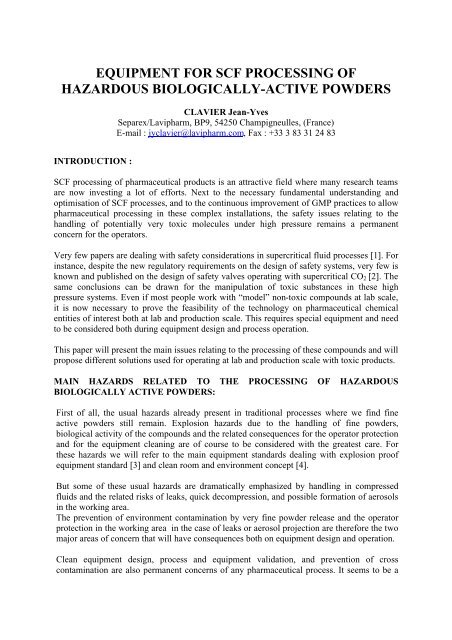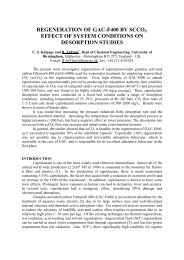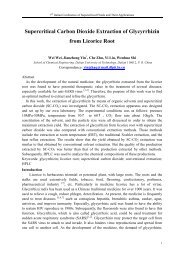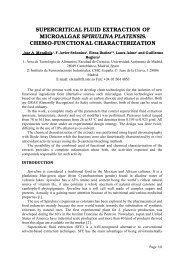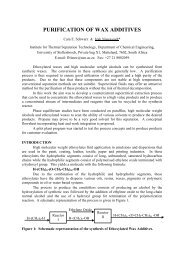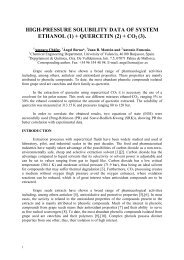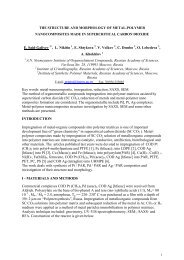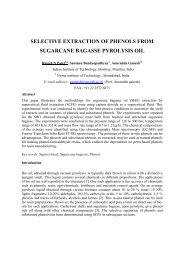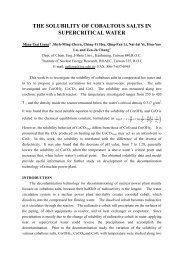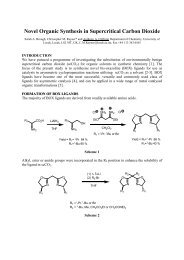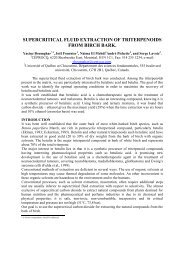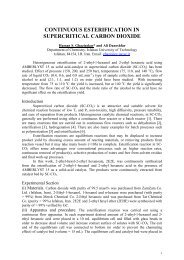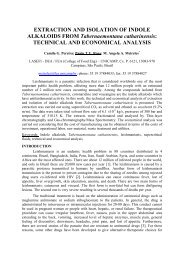equipment for scf processing of hazardous biologically ... - ISASF
equipment for scf processing of hazardous biologically ... - ISASF
equipment for scf processing of hazardous biologically ... - ISASF
You also want an ePaper? Increase the reach of your titles
YUMPU automatically turns print PDFs into web optimized ePapers that Google loves.
EQUIPMENT FOR SCF PROCESSING OF<br />
HAZARDOUS BIOLOGICALLY-ACTIVE POWDERS<br />
CLAVIER Jean-Yves<br />
Separex/Lavipharm, BP9, 54250 Champigneulles, (France)<br />
E-mail : jyclavier@lavipharm.com, Fax : +33 3 83 31 24 83<br />
INTRODUCTION :<br />
SCF <strong>processing</strong> <strong>of</strong> pharmaceutical products is an attractive field where many research teams<br />
are now investing a lot <strong>of</strong> ef<strong>for</strong>ts. Next to the necessary fundamental understanding and<br />
optimisation <strong>of</strong> SCF processes, and to the continuous improvement <strong>of</strong> GMP practices to allow<br />
pharmaceutical <strong>processing</strong> in these complex installations, the safety issues relating to the<br />
handling <strong>of</strong> potentially very toxic molecules under high pressure remains a permanent<br />
concern <strong>for</strong> the operators.<br />
Very few papers are dealing with safety considerations in supercritical fluid processes [1]. For<br />
instance, despite the new regulatory requirements on the design <strong>of</strong> safety systems, very few is<br />
known and published on the design <strong>of</strong> safety valves operating with supercritical CO 2 [2]. The<br />
same conclusions can be drawn <strong>for</strong> the manipulation <strong>of</strong> toxic substances in these high<br />
pressure systems. Even if most people work with “model” non-toxic compounds at lab scale,<br />
it is now necessary to prove the feasibility <strong>of</strong> the technology on pharmaceutical chemical<br />
entities <strong>of</strong> interest both at lab and production scale. This requires special <strong>equipment</strong> and need<br />
to be considered both during <strong>equipment</strong> design and process operation.<br />
This paper will present the main issues relating to the <strong>processing</strong> <strong>of</strong> these compounds and will<br />
propose different solutions used <strong>for</strong> operating at lab and production scale with toxic products.<br />
MAIN HAZARDS RELATED TO THE PROCESSING OF HAZARDOUS<br />
BIOLOGICALLY ACTIVE POWDERS:<br />
First <strong>of</strong> all, the usual hazards already present in traditional processes where we find fine<br />
active powders still remain. Explosion hazards due to the handling <strong>of</strong> fine powders,<br />
biological activity <strong>of</strong> the compounds and the related consequences <strong>for</strong> the operator protection<br />
and <strong>for</strong> the <strong>equipment</strong> cleaning are <strong>of</strong> course to be considered with the greatest care. For<br />
these hazards we will refer to the main <strong>equipment</strong> standards dealing with explosion pro<strong>of</strong><br />
<strong>equipment</strong> standard [3] and clean room and environment concept [4].<br />
But some <strong>of</strong> these usual hazards are dramatically emphasized by handling in compressed<br />
fluids and the related risks <strong>of</strong> leaks, quick decompression, and possible <strong>for</strong>mation <strong>of</strong> aerosols<br />
in the working area.<br />
The prevention <strong>of</strong> environment contamination by very fine powder release and the operator<br />
protection in the working area in the case <strong>of</strong> leaks or aerosol projection are there<strong>for</strong>e the two<br />
major areas <strong>of</strong> concern that will have consequences both on <strong>equipment</strong> design and operation.<br />
Clean <strong>equipment</strong> design, process and <strong>equipment</strong> validation, and prevention <strong>of</strong> cross<br />
contamination are also permanent concerns <strong>of</strong> any pharmaceutical process. It seems to be a
more critical issue here on SCF <strong>equipment</strong> <strong>for</strong> many reasons. First <strong>of</strong> all, the complexity <strong>of</strong><br />
the process and <strong>of</strong> the <strong>equipment</strong> that are composed <strong>of</strong> many small high pressure parts,<br />
sometimes difficult to clean, is a first difficulty. But these processes also integrate complex<br />
fluid recycle loop that is are major source <strong>of</strong> contamination. Cross contamination and<br />
contamination by external pollutants in the <strong>equipment</strong> will there<strong>for</strong>e be carefully checked and<br />
optimised.<br />
This will require special procedures <strong>for</strong> the <strong>equipment</strong> design <strong>of</strong> the safety systems and <strong>for</strong><br />
the operation <strong>of</strong> these systems.<br />
EQUIPMENT DESIGN ASPECTS :<br />
Contamination issues<br />
The first risk <strong>of</strong> cross contamination comes from fluid recycling. Fluid recycling that is<br />
usually not necessary at lab scale becomes mandatory <strong>for</strong> most SCF processes at large-scale<br />
[5]. The usual gravity separator or the improved cyclonic separators cannot have a perfect<br />
efficiency. Moreover, we cannot avoid to have traces <strong>of</strong> very fine particles or organic solvent<br />
concentration variation in the recycling fluid. This causes a possible risk <strong>of</strong> entrainment and<br />
product recycling, that has to be minimized to reduce the risk <strong>of</strong> cross contamination even if<br />
is possible to clean the <strong>equipment</strong>. A very simple method, firstly proposed <strong>for</strong> the preparative<br />
supercritical fluid chromatography [6] permits to maintain a constant co-solvent concentration<br />
in the fluid <strong>for</strong> the anti-solvent process. The system based on the Gibbs’ law, consists in<br />
scrubbing the CO 2 flow at a constant pressure and temperature. The outlet flow is there<strong>for</strong>e<br />
maintained at constant composition and possible contaminants are trapped in the saturation<br />
column.<br />
The second risk comes from the CO 2 supply system. This system must be designed to avoid<br />
any contamination. As back flow through check valves is always possible, it is recommended<br />
to have a separate On/Off valve that stops CO 2 flow when the feed line is not used and when<br />
there is a risk <strong>of</strong> back flow from the process. Other preventative actions consist in using a<br />
dedicated feed line from the bulk storage to the process <strong>equipment</strong>. It is also necessary to<br />
have a full traceabilty <strong>of</strong> both the bulk CO 2 <strong>for</strong> GMP compliance but also <strong>for</strong> the storage itself<br />
as some <strong>of</strong> the cylinders are provided by gas suppliers without any precaution. The possibility<br />
to clean storage tanks and eliminate the possibility <strong>of</strong> contamination coming from or going to<br />
the storage is mandatory.<br />
Then, it is recommended to split the <strong>equipment</strong> in different parts with a maximum protection<br />
to avoid contamination. The pumping section could be separated from the separation and<br />
crystallisation / atomisation sections by high efficiency filters and independent vent lines.<br />
SEPAREX developed <strong>for</strong> this purpose high pressure ceramic filters with nanometric filtration<br />
rate.<br />
At last but not least, the components will all have to be designed to ease cleaning, with high<br />
quality electro-polished surfaces, zero dead volumes, and easy cleaning connections <strong>for</strong> the<br />
different fittings, instrumentation, etc. Drains and access points shall be located to permit<br />
efficient cleaning procedures that will be carefully designed and checked.
Atmosphere release and venting issues<br />
Due the presence <strong>of</strong> <strong>biologically</strong> active compounds under pressure, the sudden release and<br />
unavoidable entrainment <strong>of</strong> compounds from a vessel through a safety valve or during a<br />
depressurisation must be considered. A single vent line or a simple atmospheric pressure<br />
vessel in which one could expect to precipitate all contaminants, is not sufficient to guarantee<br />
that no active powder will be entrained in the atmosphere or in the building air exhaust<br />
system.<br />
Different methods are proposed:<br />
- High pressure filters can be placed on most <strong>of</strong> the drain and depressurisation valves, but<br />
these filters cannot be placed on the safety vent line where the flow must be free <strong>of</strong><br />
obstacles be<strong>for</strong>e being released.<br />
- A more efficient method consists in scrubbing the effluents by a liquid. The gas is<br />
percolated in a good solvent <strong>of</strong> the product and leaves the scrubber free <strong>of</strong> powder. The<br />
design <strong>of</strong> the scrubber must be made carefully to avoid any entrainment <strong>of</strong> solvent in the<br />
vent, in case <strong>of</strong> sudden high flow rate release. The presence <strong>of</strong> liquid and the guarantee to<br />
have a good solvent <strong>of</strong> the products must be checked be<strong>for</strong>e any operation <strong>of</strong> the system.<br />
- The only method that guarantees a perfect containment <strong>of</strong> all the vented products is to<br />
design a venting system with a large vent vessel followed by a high efficiency filtration<br />
system. The vent vessel will be sufficiently large to be able to contain the whole capacity<br />
<strong>of</strong> the <strong>equipment</strong>, so that even in case <strong>of</strong> a simultaneous filter obstruction with a complete<br />
depressurisation <strong>of</strong> the <strong>equipment</strong>, the complete containment is still guaranteed. In the<br />
case <strong>of</strong> a 10 kg CO 2 capacity system, it consists <strong>of</strong> a 5000-litre atmospheric pressure<br />
vessel or a 500-litre vessel designed at 10 bar! If this is a solution <strong>for</strong> lab and pilot scale<br />
systems, alternative solutions have to be found <strong>for</strong> the design <strong>of</strong> larger production scale<br />
<strong>equipment</strong> where the active products will have to be kept as long as possible inside the<br />
contained area <strong>of</strong> the <strong>equipment</strong>.<br />
OPERATION ASPECTS<br />
Clean and protected environment solutions<br />
Equipment containing toxic products is usually placed in a clean room maintained in<br />
depression and equipped with a double air lock system <strong>for</strong> inlets/outlets.<br />
If this solution protects the <strong>equipment</strong> environment, it does not eliminate the venting system<br />
used to contain the exhaust flows and the body protection <strong>for</strong> the operator that is necessary in<br />
case <strong>of</strong> leak or in case <strong>of</strong> contact with the active.<br />
For this reason, and in order to be able to work on the most toxic molecules (cytotoxic, new<br />
chemical entities with unknown toxicity, etc.) where we usually have very small quantities <strong>of</strong><br />
product, we have developed a very small scale <strong>equipment</strong> placed in an isolator (figure 1).<br />
This provides the advantage <strong>of</strong> having a perfect containment with the possibility to work in
clean and possibly sterile environment, with a single protection, <strong>for</strong> both the environment and<br />
the operator. It reduces the air volume to be treated and is found to be an economical way <strong>of</strong><br />
working with <strong>hazardous</strong> products.<br />
The isolator will be preferably manufactured with safety glass or with polycarbonate to have<br />
both a good mechanical resistance to projections, and solvent resistance. In case <strong>of</strong> utilisation<br />
<strong>of</strong> flammable or explosive solvents, solvent sensors shall be put in the isolator. Components<br />
will be manufactured with ex-pro<strong>of</strong> standards or the isolator will allow a nitrogen blanketing.<br />
Figure 1 : New chemical entities process screening <strong>equipment</strong> placed in an isolator<br />
When larger <strong>equipment</strong> is used, the general arrangement <strong>of</strong> the process component will have<br />
to be carefully studied so that the risk <strong>of</strong> contamination is reduced. High-level containment<br />
devices like isolator or laminar flux will be used <strong>for</strong> the critical parts <strong>of</strong> the process, (particle<br />
<strong>for</strong>mation or particle collection vessels) as the other parts <strong>of</strong> the process are in a clean room<br />
with lower air quality level. To ease the cleaning and to maintain high air quality, we need to<br />
place the minimum amount <strong>of</strong> components in “ultra clean” environment, but we need to keep<br />
all the parts potentially exposed to the active product, protected from any active<br />
contamination (figure 2 and 3).<br />
Preventative maintenance, periodic inspection <strong>of</strong> all seals, valves, pumps, etc… are <strong>of</strong> course<br />
recommended.<br />
Component design will avoid dynamic seals, threaded parts and all fragile dynamic parts<br />
more likely to be potential sources <strong>of</strong> contamination, and rupture.<br />
Body protection and automation solutions<br />
When it is not possible to place the <strong>equipment</strong> behind an isolator, it becomes mandatory to<br />
consider the possible hazards related to the immediate proximity <strong>of</strong> the operator with highpressure<br />
parts containing CO2 + active <strong>hazardous</strong> substances. Body protections (masks,
complete body protection, or mask equipped with independent air breathing system) must be<br />
imposed according to the chemical and physical properties <strong>of</strong> the manufactured products.<br />
Emergency procedures that will consider the risk <strong>of</strong> fire, the risk <strong>of</strong> very big leaks and large<br />
product contamination must be put in place in the lab or in the factory. Quick evacuation<br />
plans <strong>for</strong> the personnel and procedures associated with the risks <strong>of</strong> environment<br />
contamination, maintenance and cleaning procedures to be planned after the accident, must be<br />
considered.<br />
Even if ventilation systems <strong>of</strong> clean rooms are large and usually oversized with quick air<br />
renewal rates, the available space is low and a quick CO 2 release in the room can lead to high<br />
CO 2 concentrations. CO 2 detectors must be available with special emergency procedures <strong>for</strong><br />
the personnel.<br />
In any case, automated operation is to be recommended when possible, especially automated<br />
depressurisation procedures that have to be carefully optimised and controlled in order to<br />
avoid line plugging with powder or with dry ice, but also to avoid contamination <strong>of</strong><br />
<strong>equipment</strong> parts.<br />
Automated high-pressure vessel opening/closing systems will have to be put in place <strong>for</strong> large<br />
vessels. The cleanness and non contamination <strong>of</strong> these automated systems (seals, lubricants,<br />
actuators, etc.) have to be appreciated.<br />
Figure 2: “Ultra clean” 7-litre pilot scale<br />
<strong>equipment</strong> designed in 2 skids to be<br />
placed in a “grey” room (pumping,<br />
heating, vent) and in class B environment<br />
<strong>for</strong> the main particle <strong>for</strong>mation vessel.<br />
Figure 3: Drawing <strong>of</strong> the automated<br />
opening closing system.<br />
For large production vessels, fully automated systems operating under large laminar flow<br />
hoods are recommended, not only <strong>for</strong> safety, but also <strong>for</strong> cleaning and economical<br />
considerations.<br />
Finally, any process concept allowing to combine the powder <strong>for</strong>mation process and the prior<br />
or further manufacturing steps (purification, drying, <strong>for</strong>mulation, packaging, etc.) will <strong>of</strong>
course reduce the risk associated with the handling <strong>of</strong> these <strong>hazardous</strong> process and probably<br />
reduce the manufacturing cost.<br />
CONCLUSION<br />
Keeping the best possible level <strong>of</strong> safety on SCF processes is crucial <strong>for</strong> the development <strong>of</strong><br />
this new technology; and any accident would have a dramatic impact on the future <strong>of</strong> many<br />
pharmaceutical applications actually under development.<br />
A systemic approach where safety considerations takes into account the high-pressure process<br />
engineering, particle engineering, clean rooms concepts, biology, <strong>for</strong>mulation and galenic<br />
approaches, is the key <strong>for</strong> the success <strong>of</strong> these new process developments.<br />
REFERENCES:<br />
[1] : CLAVIER J.-Y., PERRUT M., Safety in Supercritical Operations. In: R von Rohr, C<br />
Trepp, ed. High Pressure Chemical Engineering, Process Technology Proceedings, 12,<br />
Amsterdam: Elsevier, 1996, pp 627-631.<br />
[2] : LI Z., PERRUT M., Chem. Eng. Comm., 117, 1992, p. 415.<br />
[3] : European Standard EN 50014, EN 50020, 94/9/CE and 1999/92/EC Directives<br />
[4] : ISO 14644-1 to ISO 14644-7 : Cleanrooms and associated controlled environments<br />
[5]: CLAVIER J-Y, PERRUT, M., In York P., Kompella U.B., Shekunov B.Y., “Drug<br />
delivery and Supercritical Fluid Technology, Marcel Decker (New York) 2003, In press.<br />
[6]: PERRUT M., JUSFORGUES J.. Process and <strong>equipment</strong> <strong>of</strong> separation using a<br />
supercritical fluid. European patent EP 0 254 610, 1988.


